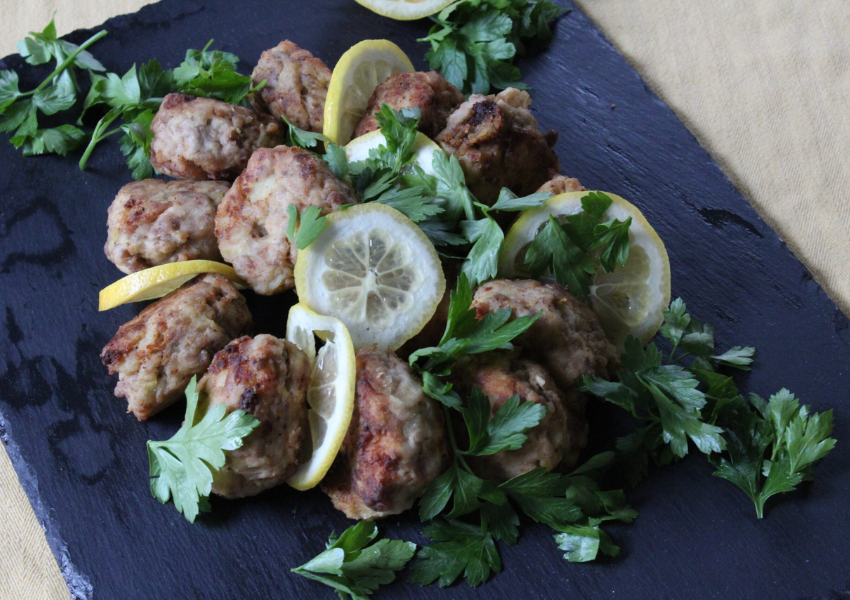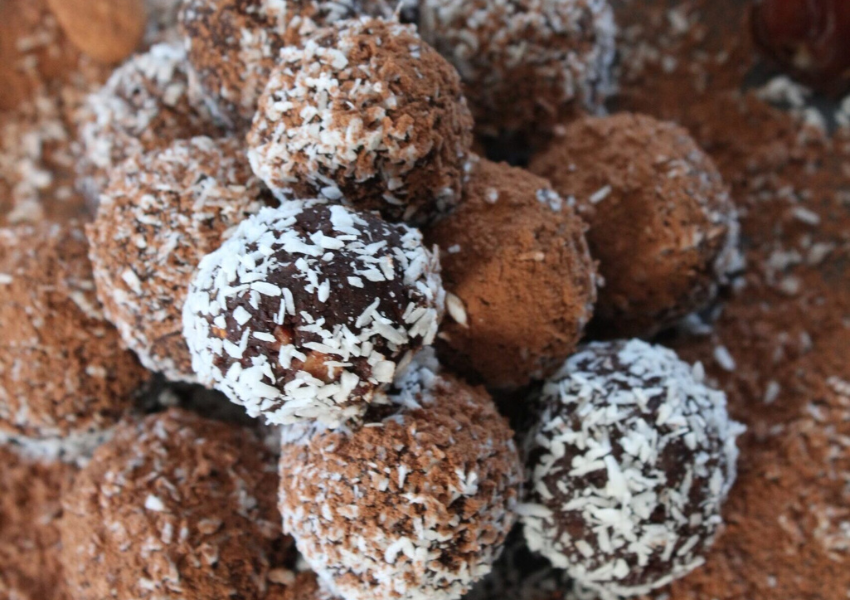The Ambassador's Cauliflower with Tahini and Pomegranate

This recipe was given to one of our community members by the ex-ambassador of Israel to Spain, Alon Bar, after having been served it by the minister himself! Apparently, he grew up eating this dish on the kibbutz where he spent his childhood. Although the tahini is a traditional condiment on the Israeli table, the addition of the pomegranate seeds brings an original splash of tart brightness to the tahini’s creamy bitterness, while also symbolizing the hope for abundance in the new year.
Ingredients
1 medium cauliflower, cut into florets
3 tablespoons olive oil
1 1⁄2 teaspoons kosher salt
Juice of half a lemon
1⁄2 cup of tahini
1 clove of garlic, crushed
1⁄4 – 1⁄2 cup cold water
1⁄2 cup chopped parsley
Seeds of 1 pomegranate
Process
Preheat the oven to 350°F. In a large bowl, mix the cauliflower florets with the olive oil and 1 teaspoon of the salt. Place the sheet in the oven and roast the cauliflower for 45 minutes, undisturbed.
Meanwhile, mix the tahini with the crushed garlic and salt. Add the lemon juice. Whisk in the water, using less if you’d like a sauce with a thicker consistency and more water if you’d like a more pourable sauce. You’ll notice the color of the tahini change from very dark to quite light with the addition of the water.
After the cauliflower has roasted for 45 minutes, remove it from the oven and let it cool for 5 minutes. Then, place on a platter. Drizzle with the tahini sauce, reserving some to serve on the side. Sprinkle with the chopped parsley and pomegranate seeds.
Leek Kofte

Makes about 30 patties.
This recipe comes from a community member, Rudi, who hails from Turkey, where this recipe is quite common and goes by many names. This is his mother’s recipe. Indeed, whether they are called kofte or kufta – the two other common names for these meatballs – they are found all over the Middle Eastern, Mediterranean, and North African regions. And it’s no wonder – these leek meatballs make a particularly auspicious and delicious centerpiece or hors d’oeuvre for your meal.
Ingredients
1 pound leeks, cleaned and thinly sliced to the light green part (about 2 cups thinly sliced leeks) 3 tablespoons olive oil
1⁄2 pound ground beef (20% fat preferable) 2 medium waxy potatoes, such as Yukon Gold, peeled and cubed
1 cup flour (matzo meal can be substituted during Passover)
2 eggs, lightly beaten
1 cup vegetable or olive oil, for frying
2 tsp salt
1⁄2 tsp. freshly ground black pepper
1⁄2 tsp. Aleppo pepper or smoked paprika (optional)
Chopped parsley, to garnish Lemon wedges, to garnish
Process
Set the potatoes in a 4 quart saucepan with 1 teaspoon of salt and fill the pan with enough water to cover the potatoes. Boil the potatoes for 10 minutes, or until fork tender. Reserving 1⁄2 cup of the cooking water, drain the potatoes and mash them thoroughly with a fork or masher, so no chunks remain.
Meanwhile, heat the 3 tablespoons olive oil in a large skillet over medium heat. Add the leeks and sauté for 5 minutes, until the leeks soften. Pour the 1⁄2 cup reserved cooking water over the leeks and cook, stirring occasionally, for another 10 minutes, until the leeks are completely soft. Let cool for 10 minutes, or until the leeks can be handled. Over a bowl or the sink, squeeze the leeks to express the excess liquid and place them in a separate bowl.
After extracting the excess liquid from the leeks, combine them with the ground beef, mashed potatoes, 1⁄4 cup of flour, eggs, 1 teaspoon salt, black pepper, and Aleppo pepper or paprika if using. Mix thoroughly. The mixture should have the consistency of a thick paste.
Ceutan Fish (Fish with Pipirrana)

Serves 4.
This dish comes from the city of origin of Yael, the Reform Community’s director. She explains that the recipe is not inherited from her family but rather was one that her mother adopted from a neighbor that became popular in the 70s in Ceuta. The fish, ideally one of a meatier variety that’s good for searing, is seared on a griddle for exactly the right amount of time to be later crowned with a salad of fresh vegetables. This salad, which tops the seared fish in order to mix with the cooked fish’s juices, is called Pipirrana. It’s a nice, fun little name that comes from the south of Andalusia, specifically Cádiz. Cádiz and her North African city of birth, Ceuta, are both port cities, between the European and African continents. Yael explains that this mix of culinary and cultural influences in the cities on the Strait of Gibraltar contributes to the unique story and delicious history of this salad, which tastes as good atop cod as it does over a meatier fish, such as tuna.
Ingredients
1 pound tuna, Atlantic bonito, tuna, or cod fillet, skinned and de-boned
6 tablespoons olive oil
3 medium salad tomatoes
1 large red pepper
1 sweet onion
3⁄4 cup finely chopped parsley 1 cucumber (optional)
Juice of 1 lemon
1 teaspoon salt
1⁄2 teaspoon freshly ground black pepper
Process
Finely chop the tomatoes, red pepper, onion, and cucumber (if using). Mix to combine in a bowl. Add the parsley, lemon juice, 3 tablespoons of olive oil, 1⁄2 teaspoon of salt, and a generous pinch of pepper. Mix well to combine and let rest while cooking the fish.
Meanwhile, heat the remaining 3 tablespoons of oil in a large, shallow skillet over medium-high heat. Once the oil is heated, place the fish in the pan. Cook for 3 minutes on one side, then flip to other side and cook for 3 more minutes, until just cooked through. Remove from heat and top with the Pipirrana.
Date Truffles

Ingredients
8 oz. whole dates
3⁄4 cup hazelnuts or walnuts
1⁄2 cup cocoa powder
1⁄2 cup shredded coconut (your choice of sweetened or unsweetened)
Process
In a food processor, grind the dates to a smooth paste. Add a tablespoon or two of water in case they are too dry. Add the nuts and blend them with the dates until it forms a thick paste. Transfer the date-nut mixture to a bowl. Fold the cocoa powder in with a spatula.
Take rounded tablespoonfuls of the mixture and roll into a small ball. Continue until all the date mixture is formed into little balls. Roll each ball in coconut to coat.
Store in the refrigerator until ready to eat.
Sara Gardner is a PhD student in the Department of Spanish & Portuguese Studies at the University of Minnesota
Reflections
For any holiday seder
Thinking about the ways that the Reform Jewish Community of Madrid incorporates symbolic ingredients into their seders for both Rosh Hashanah and Passover, what special foods would you like to bring into your celebration? What do they represent to you?
For Passover
What flavors are most important to your Passover seder? Why? Are they related to your past, present, or future? Are they a part of the meal or do they belong to another element of the seder?
For Passover
What is one way you can express the Passover story through food in a new way this year? (For example, could you make the ten plagues edible? Could the four questions each have a bite associated with them? Feel free to get creative and see what ideas come to life!)
Want more?
Get curated JewishArts.org content in your inbox



